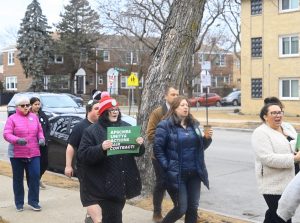NEIU to offer same in-state tuition for Puerto Rican residents
November 28, 2017
NEIU announced it will charge in-state tuition to students who are residents of Puerto Rico for a two-year period during the Board of Trustees meeting of Nov. 16.
The disaster of Hurricane Maria in September left thousands homeless and without water and electricity. Colleges and universities in Puerto Rico were closed down, leaving residents uncertain of when they will open again.
The island’s economy will shrink roughly 8 percent in 2018 due to the hurricane damage, according to a November forecast by the Economist Intelligence Unit. Over 27,000 jobs were also lost since October, forcing almost 20 percent of the island’s population to leave Puerto Rico.
Puerto Ricans are the second largest Hispanic group in Chicago.
The university inquires each student whether they are of Latino culture or origin. At NEIU, 33 percent of the student population identified as Hispanic, which means about 5-6 percent identify as Puerto Rican or from Puerto Rican descent.
“In talking with the former president of one of the branch campuses of the University of Puerto Rico, she suggested that she thought in terms of universities [re-opening], it would be a two-year period,” Interim President Richard Helldobler said.
“We want to give them the option that they can complete their degree or continue their degree in the absence of their home university being functional,” Helldobler said.
The two-year period will last from Jan. 1, 2018 to Dec. 31, 2019. Students who might need one or two classes to complete their degree after the two-year period might be eligible to get an extension.
“There are many people from my homeland that live [in Chicago] who have become the first responders due to the weak FEMA response,” Trustee Marvin Garcia said. “We have to support our families on the island. This is a major catastrophic situation, and it is only going to get worse.”
Additionally, Puerto Rican residents do have access to the Federal Financial Aid and Pell grants, but would not have immediate access to MAP grants until they declare Illinois citizenship. Enrollment Management Services will dedicate a personal guide to help students through the process.
In order to qualify for in-state tuition, students from Puerto Rico will be required to seek a residency determination from the Office of Enrollment Services. Interested students should contact Associate Director of Admissions Processing and Operations Steve Pajak at (773) 442-4013.
The Board Finance Committee also recommended to the Board an overall tuition increase of 5 percent and a 1.7 percent increase in mandatory student fees, based on 10-year state
appropriation history, tuition revenues, student financial aid, enrollment trends, base credit hours.
Due to the financial uncertainty of the fiscal year 2019, because of the budget impasse that the university had to undergo for two years, the Board suggested the increase to meet the projected budget shortfalls.
The university does not know when the fiscal year 2019 appropriation will be provided and does not know what the appropriation will be.
Increases are proposed in four student fees: student activity, student union, campus improvement, and library. An offsetting proposed decrease in the Parking Fee leads to an overall recommended student fees increase of 1.7 percent.
NEIU has also begun studying an expansion of its new differential tuition structure and “plans to research the manner in which differential tuition would benefit students through the lesser assignment of tuition expense to general education and pre-major programs, lowering its ‘sticker price’ for the highly competitive new student and transfer markets while enabling appropriate funding for some selected and more expensive academic programs,” according to the president’s report.
The proposed action item was voted on and accepted by the Board.







Chicago Lampoon • Dec 21, 2017 at 12:17 am
Of course virtually anyone can walk in off the street and get into this laughably, silly school.
No serious students really go here.
The only question that remains, is why do the taxpayers of Illinois still pay for this silly place?